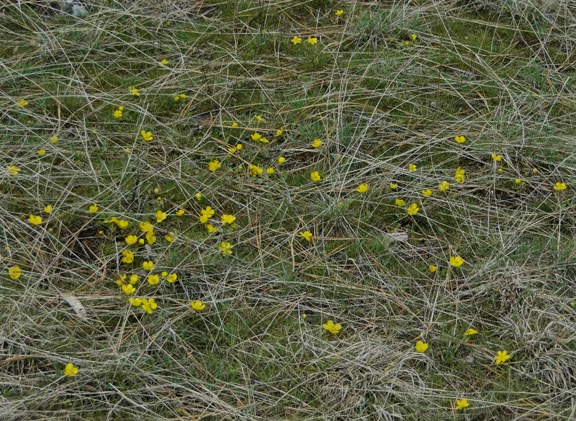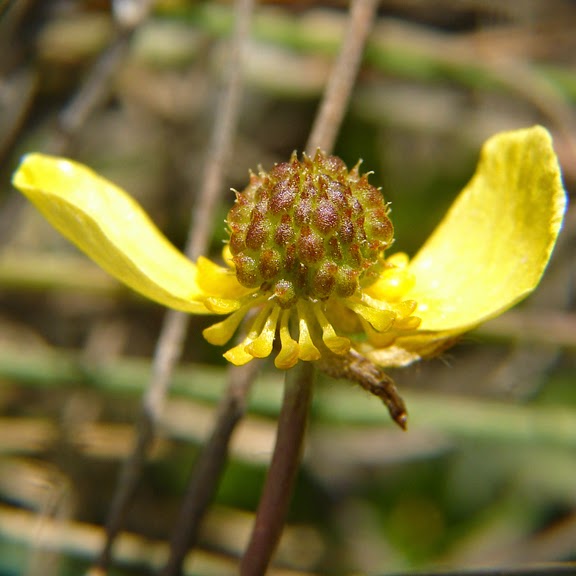11/7/2014 1:10 PM
11/8/2014 4:33 PM
Ranunculus glaberrimus, sagebrush buttercup; Ranunculaceae
Paul Slichter uses wax buttercup for a common name.
010
Only one other Ranunculus species is found in the park,
Ranunculus arvensis, corn buttercup. It is introduced and it does not bloom
till mid May.
The name Ranunculus is Late Latin for "little
frog," from rana "frog" and a diminutive ending. This
probably refers to many species being found near water, like frogs. However, R.
glaberrimus seems to prefer drier areas.
All parts of R. glaberrimus are poisonous. You have to eat a
lot to be seriously affected but if you eat a lot it can be very bad.
Native Americans rubbed meat with R. glaberrimus as coyote bait.
And are said to have rubbed it on their arrow heads.
From Wikipedia: In the interior
of the Pacific Northwest of the
R. glaberrimus is the second plant to bloom in Drumheller Springs Park
There are two varieties of Ranunculus glaberrimus, var.
glaberrimus and var. ellipticus. The visible difference is in the shape of the
leaves. The leaves of var. glaberrimus are quite round, completely round early
but developing lobes distally, away from the stem. Some times the lobes are
quite deep. The leaves of var. ellipticus are long and narrow. They may be
distinctly pointed or their apex [tip] may be somewhat rounded.
R. glaberrimus var. glaberrimus
Two leaves with deep lobes
020
It seems that young leaves are quite round and the lobes
develop later.
This photos is from January first, 2011. We do not always
have snow cover in January.
025
R. glaberrimus var. ellipticus
030
050
Another difference is that var. glaberrimus is found at
lower altitudes than var. ellipticus, but both varieties are found at
mid-altitudes and both are found in Drumheller Springs park.
Var. ellipticus also likes high latitudes. Both varieties
are found all over western United
States . Var. ellipticus is found north to Hudson ’s Bay in Canada .
One would suppose that, therefore, var. ellipticus would be
first to bloom in Drumheller
Springs Park
I saw Ranunculus glaberrimus, sagebrush butter cup in bloom
February 22, 2010, January 15, 2011, and not till March 14, 2012.
February 22, 2010, Riverside State Park
060
January 15, 2011, Drumheller
Springs Park
070
March 14, 2012, Drumheller
Springs Park
These seem to be var. ellipticus leaves. Ellipticus is
allowed 3 lobed leaves as cauline leaves. [verify.]
Note Olsynium douglasii, grass widow stems with their
distinctive stripped look above R. glaberrimus ver. Ellipticus.
080
Also March 14, 2012, the leaves are hard to see but they are
var. glaberrimus. There were lots of blossoms. I photographed a bud with var.
glaberrimus leaves a week earlier.
090
Stems and Branches
Both varieties may have scapes for flower-stalks, [scape –
no cauline leaves, no branches] and both may have cauline leaves and may be
branched.
R. glaberrimus var. ellipticus
100
I don’t have a photo of var. glaberrimus with branches but
this var. glaberrimus has cauline leaves and buds in the axils that,
presumably, became branches.
110
Petals
The number of petals in the corolla is often 5 but I have
seen 13 and Ken Swedberg has counted 14. I count 12 in the photo below.
120
The petals of R. glaberrimus occasionally have a shiny
lacquered look, in Drumheller Sp;rings Park.
Paul Slichter characterizes the petals of R. glaberrimus
var. glaberrimus as shiny and has ‘wax buttercup’ as an alternative common
name.
130
Usually the petals in Drumheller Springs
Park
140
Sometimes you see white areas on the petals. The white areas
could, I suppose be merely age, could be disease, insect damage or weather
damage.
150
I think I have photos of petals with a rather squared off
apex but I don’t seem to find one at the moment.
*
Nectary – a source of nectar to attract insects
Burke refers to a nectary scale that is wedge-shaped and
forms a deep pocket with hairs along the free portion.
E-FLORA BC says of the petals, “… nectary on upper surface,
the nectary scale smooth or fringed with hairs …”
Montana Plant Life says “… Nectary scale wedge-to fan shaped
… the side edges joined most of the length, forming a deep pocked, the upper
edge usually hairy.”
Jepson Herbarium says of Ranunculus genus petals: “…
nectaries near base, pocket-like or with flap-like scale; …”
Jepson says of R. glaberrimus petals; “… nectary scale
glabrous or ciliate.”
Robert Carr has a photo of a petal with what seems to be a
nectary scale and pocket at its base. He has no explanatory text with the
photo:
Robert Carr: Nectary scale - probably
*
I don’t have a photo showing the nectary and want one.
Another job for 2015.
I wonder if dim, out of focus square-ish shadows in the
photo below might be nectary scales.
160
Now that I think of it, if the nectary scale is tucked away
under the yellow anthers, at the base of the petals, it’s in a good place for
insects to get pollen on their bodies, but not such a great place for them to
deliver pollen to the stigma on the green pistils. Insects bearing pollen from
other plants have no attraction I know of that would help get their pollen
delivered to the pistils.
*
Sepals – the Calyx
The sepals protecting an R. glaberrimus var. glaberrimus bud
are green bracts fringed with purple that turn purple. They are smooth with
respect to hair [glabrous]. The blossom expands pushing them aside.
185
190
200
The sepals protecting an R. glaberrimus var. ellipticus bud
are at least some times, hairy.
210
220
The sepals change color as the flower matures. Eventually
they resemble an outer ring of shorter petals.
The bracts, or sepals, as a unit are the calyx. The calyx
falls away rather soon.
Stamen and Pistil
R. glaberrimus is thought to be an example of flowers
somewhat early on the evolutionary scale. Its flower has many male reproductive
organs [40-80] and many female reproductive organs [30-150]. Modern plants have
few reproductive organs efficiently arranged.
In the photo below, you can see the yellow anthers of many
stamen surrounding many green pistils.
240
The photo below is Olsynium douglasii, grass widow, the
transparent style and stigma of the pistil reaching out beyond yellow anthers
covered with pollen.
250
Early in the maturity of the R. glaberrimus flower the
yellow anthers of the stamen nearly enclose the green pistils.
260
The stamen pull away exposing the pistils.
270
280
This looks a little strange. The petals and some stamen are
pulled back but some stamen are erect.
The sepals are said to fall away early but they seem to be
present, here, seen through the cracks in the petals.
290
The petals fall away.
300
310
The stamen fall away.
320
The pistils dry.
A minority of the pistils become fruit.
330
The fruit is an achene. Achenes do not open on maturity. The
hull must rot away.
The beak on the fruit is a persistent style.
340
I found little information on the stamen and the pistils.
There seems to be a transparent stigma at the top of the
pistil. The style seems to be a broad neck tapering from the ovary to the
stigma that persists on the fruit.
350
In the photo below some anthers have released their pollen.
None of the pistils have developed stigma. The evidence of one photo is weak,
of course, but this photo suggests that R. glaberrimus’ strategy to encourage
cross pollination is to release its anther’s pollen before its pistils can
accept pollen.
360
The perennating organ [the organ that makes them perennials]
of some Ranunculus is a caudex. Apparently a caudex is a thickened base of the
stem that survives over winter, that is, between growing seasons, whether or
not the interim is winter.
The available caudex photos online show very thick bases,
tuber-like bases, above ground.
There is no such above ground base on R. glaberrimus. Its
perennating organ is thickened roots.
370
380
390
It looks, here, like the number of roots increase from year
to year.
400
One feature of R. glaberrimus mentioned by my resources is a
globular receptacle. I have no photo showing the receptacle. Another task for
2015.
No indication of a globe at the of the stem in the photo
below.
One source speaks of the receptacle being obscured by
aborted pistils. See photo 330 above.
410
*-*-*-*-*-*-*
OTHER COLLECTIONS OF PHOTOS:
Robert Carr
Ranunculus glaberrimus var glaberrimus
*
Gerald Carr
R. glaberrimus var. ellipticus
R. glaberrimus var. glaberrimus
*
Paul Slichter
Elliptical Buttercup … other varieties
Ranunculus glaberrimus var. glaberrimus, sagebrush
buttercup, wax buttercup
*
Ranunculus in Washington
State and in Spokane County
Burke Herbarium, UW, lists 25 Ranunculus in Washington State Spokane
County
The 5 yellow petals, the center of many pistils and stamen
look similar but the leaves and branching are usually quite different:
R. alismifolius, plantain-leaf buttercup
R. arvensis, corn buttercup Whitman County [Drumheller Springs
Park
R. cymbalaria, alkali buttercup Pend Oreille
County
R. flammula, greater creeping spearwort
R. gelidus, arctic buttercup Lincoln County
R. glaberrimus, sagebrush buttercup
R. gemelinii, small yellow buttercup Pend Oreille, Stevens and Whitman
Counties
R. macounii, Macoun’s b uttercup
R. orthorhynchus, straight-beaked buttercup
R. repens, creeping buttercup Pend Oreille and Stevens Counties
R. sceleratus, cursed buttercup Pend Oreille, Stevens and Lincoln Counties
R. Testiculatus, horn seed buttercup Stevens, Lincoln , Adams and Whitman Counties
*
There are at least two varieties of R. glaberrimus in Drumheller Springs Park
Ranunculus arvensis blooms later in the year, mid-May. It is
introduced.
*









































Nice macros! Any advice for distinguishing the var. ellipticus from var. glaberrimus? Given the variety I see hereabouts (and not clearly sorted by elevation), either there's a lot of genetic diversity or they are sensitive to micro-climate etc. Thanks!
ReplyDelete